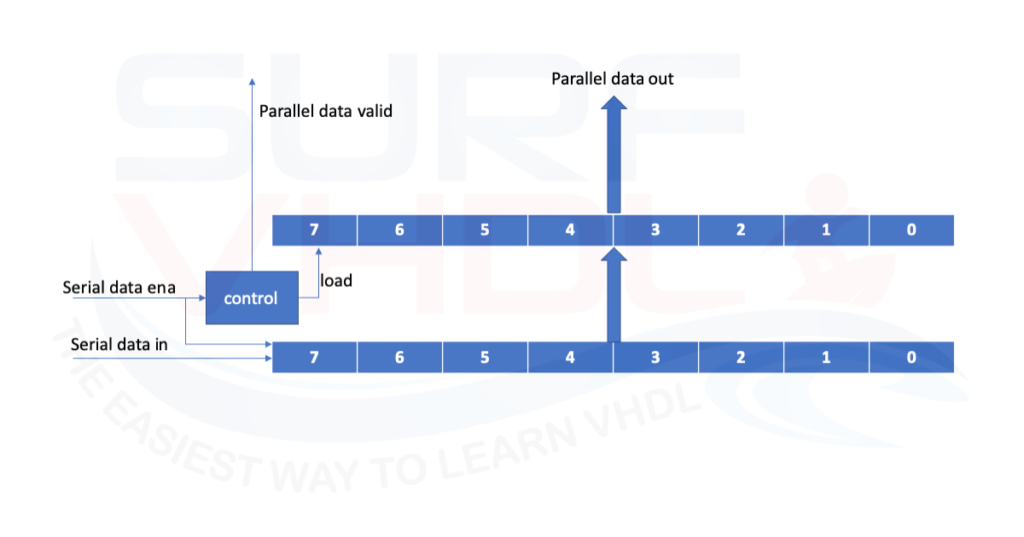
Because the data clocked into SDI eventually appears at SDO (N clock cycles later), a single I/O port can address multiple DACs. LDAC and SCLK are fed in parallel to all the DACs in the chain.
#PARALLEL TO SERIAL CONVERTER WIKI SERIAL#
Each DAC has a Serial Data Out (SDO) pin that connects to the Serial Data In (SDI) pin of the next DAC in the chain.
#PARALLEL TO SERIAL CONVERTER WIKI HOW TO#
The figure shows how to connect multiple DACs to a single I/O port. One way of getting around this problem is to use serial DACs that can be daisy-chained together. But there may be a limit to the number of lines on the processor that can be configured to transmit Chip Select signals. The Chip Select signals will require a line from each device to the interface. Then, other ports on the processor could be used to generate Chip Select signals to enable the DACs individually. But a number of serial DACs could be connected to the serial I/O port of the processor. Serial converters cannot in general be mapped into a processor's memory. Clearly, a serial interface, that can have as few as two wires, is much more economical. It requires a parallel data bus, along with some control signals, to all of the remote locations. However, this configuration has a significant disadvantage. You would then program each DAC by simply doing a Write command to the appropriate I/O location. With parallel DACs, you could map each one into a memory mapped I/O location, as shown in the figure. Initially, you must decide whether to use serial or parallel DACs. My digital-to-analog converters have to be physically remote from the central processor and from one another. More significantly, board space is saved because serial interface connections require fewer PCB tracks. This makes it possible to package a 12-bit serial ADC or DAC in an 8-pin DIP or SO package.

From a space saving point of view, serial converters offer a clear advantage because of reduced device pin-count. The key difference between serial and parallel data converters lies in the number of interface lines required. When a conversion is complete, the AD7892 interrupts the DSP, which responds by doing a single read of the ADC's decoded memory address. The figure shows the AD7892 interfaced to an ADSP-2101. It should be evident that the serial interface, in this case, must be bi-directional.Ī parallel ADC, on the other hand, connects directly (or possibly through buffers) to the data bus of the processor it is interfaced with. The register's bits control such functions as selecting the channel to be converted, putting the device in power-down mode, and starting a conversion. In this example, the DSP's serial port is used to program an internal 5-bit register in the ADC. The DSP usually (but not always) supplies an additional framing pulse that is active either for one cycle at the beginning of the communication or, as shown (TFS/RFS), for the duration of the transmission. To distinguish the bits of the serial data stream from one another, a clock signal (SCLK) must be provided, usually by the DSP However, sometimes the ADC supplies this clock as an output. The data stream also includes three additional bits that identify the input channel that the AD7890's multiplexer is currently selecting. The 12 bits that constitute the conversion result are transmitted as a serial data stream over a single line. Also shown is the timing sequence that the DSP uses to communicate with the ADC. The figure shows an AD7890 8-Channel multiplexed 12-bit serial A/D converter (ADC) connected to the serial port of an ADSP-2105 digital signal processor (DSP). In doing this we will dispel some myths about serial data converters. Let's start by looking at how a serial interface works and then compare it to a parallel interface. What do I need to know to choose and use one?Ī. I need data converters to fit in a tight space, and I suspect that a serial interface will help. See also byte, channel, convert, data unit, device, digital, fiber optic transmission system, fiber optic link, fiber optic transmission system, fiber optic trunk, input, output, parallel, parallel port, parallel-to-serial conversion, sequence, serial.Ask The Applications Engineer-19: Interfacing To Serial Converters-I

A device that converts a spatial distribution of signals that represent information into a corresponding time sequence of signals that represent the same information, such that each of the parallel input signals requires a separate channel, i.e., a parallel port, while the serial output requires only a single channel, i.e., a serial port. Note: Parallel-to-serial converters are used in electronic and fiber optic transmission systems, such as electronic or fiber optic links. A digital device that converts a group of simultaneous inputs on two or more parallel channels, often constituting a specific data unit, such as a byte or a word, into corresponding time-sequenced signal elements on a single channel.


 0 kommentar(er)
0 kommentar(er)
